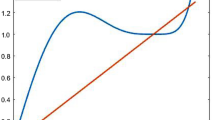Abstract
Solving Total Least Squares (TLS) problemsAX≈B requires the computation of the noise subspace of the data matrix [A;B]. The widely used tool for doing this is the Singular Value Decomposition (SVD). However, the SVD has the drawback that it is computationally expensive. Therefore, we consider here a different so-called rank-revealing two-sided orthogonal decomposition which decomposes the matrix into a product of a unitary matrix, a triangular matrix and another unitary matrix in such a way that the effective rank of the matrix is obvious and at the same time the noise subspace is exhibited explicity. We show how this decompsition leads to an efficient and reliable TLS algorithm that can be parallelized in an efficient way.
Similar content being viewed by others
References
C.H. Bischof and P.C. Hansen, Structure-preserving and rank-revealing QR factorizations, SIAM J. Sci. Stat. Comput. 12 (1991) 1332–1350.
T.F. Chan, Rank revealing QR factorizations, Lin. Alg. Appl. 88/89 (1987) 67–82.
T.F. Chan and P.C. Hansen, Computing truncated singular value decomposition least squares solutions by rank revealing QR-factorizations, SIAM J. Sci. Stat. Comput. 11 (1990) 519–530.
T.F. Chan and P.C. Hansen, Some applications of the rank revealing QR factorization, SIAM J. Sci. Stat. Comput. 13 (1992) 727–741.
W.R. Ferng, G.H. Golub and R.J. Plemmons, Adaptive Lanczos methods for recursive condition estimation, Numer. Alg. 1 (1991) 1–19.
L.V. Foster, Rank and null space calculations using matrix decomposition without column interchanges, Lin. Alg. Appl. 74 (1986) 47–71.
G.H. Golub and C.F. van Loan,Matrix Computations, 2nd ed. (The Johns Hopkins University Press, Baltimore, MD, 1989).
N.J. Higham, A survey of condition number estimation for triangular matrices, SIAM Rev. 29 (1987) 575–596.
D.J. Pierce and R.J. Plemmons, Fast adaptive condition estimation, SIAM J. Matrix Anal. Appl. 13 (1992) 274–291.
G.T. Shroff and C.H. Bischof, Adaptive condition estimation for rank-one updates of QR factorizations, SIAM J. Matrix Anal. Appl. 13, no. 4 (1992) 1264–1278.
G.W. Stewart, The economical storage of plane rotations, Numer. Math. 25 (1976) 137–138.
G.W. Stewart, On the implicit deflation of nearly singular systems of linear equations, SIAM J. Sci. Stat. Comput. 2 (1981) 136–140.
G.W. Stewart, An updating algorithm for subspace tracking, IEEE Trans. Signal Proc. 40 (1992) 1535–1541.
R. Mathias and G.W. Stewart, A block QR algorithm and the singular value decomposition, Lin.Alg.Appl. (1992), to appear.
G.W. Stewart, Updating a rank-revealing ULV decomposition, Techn. Report UMIACS-TR 91-46, CS-TR 2627, Dept. of Computer Sciences, Univ. of Maryland, MD (1991), to appear in SIAM J. Matrix Anal. Appl.
G.W. Stewart, Updating URV decompositions in parallel, Techn. Report UMIACS-TR 92-44, CS-TR 2880, Department of Computer Sciences, Univ. of Maryland, MD (April 1992).
S. van Huffel, On the significance of nongeneric total least squares problems, SIAM J. Matrix Anal Appl. 13 (1992) 20–35.
S. van Huffel and J. Vandewalle, The partial total least squares algorithm, J. Comput. Appl. Math. 21 (1988) 333–341.
S. van Huffel and J. Vandewalle, Analysis and solution of the nongeneric total least squares problem, SIAM J. Matrix Anal. Appl 9 (1988) 360–372.
S. van Huffel and J. Vandewalle, Iterative speed improvement, for solving slowly varying total least squares problems, Mech. Syst. Sign. Proc. 2 (1988) 327–348.
S. van Huffel and J. Vandewalle,The Total Least Squares Problem: Computational Aspects and Analysis, Frontiers in Applied Mathematics series, Vol. 9 (SIAM, Philadelphia, 1991).
S. van Huffel, J. Vandewalle and A. Haegemans, An efficient and reliable algorithm for computing the singular subspace of a matrix, associated with its smallest singular values, J. Comput. Appl. Math. 19 (1987) 313–330.
M.D. Zoltowski, Signal processing applications of the method of total least squares,Proc. 21st Asilomar Conf. on Signals, Systems and Computers, Pacific Grove, CA (November 1987) pp. 290–296.
Author information
Authors and Affiliations
Additional information
Communicated by Å. Björck
Rights and permissions
About this article
Cite this article
Van Huffel, S., Zha, H. An efficient Total Least Squares algorithm based on a rank-revealing two-sided orthogonal decomposition. Numer Algor 4, 101–133 (1993). https://doi.org/10.1007/BF02142742
Received:
Revised:
Issue Date:
DOI: https://doi.org/10.1007/BF02142742




